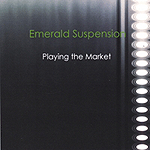
« PREVIOUS ENTRY
Cats in the henhouse
NEXT ENTRY »
Dress your Roomba like a little french maid

The stock market has long driven investors into a mild form of schizophrenia, in which they’re obsessed with uncovering the mystical patterns that supposedly underpin the chaos. UI architects develop massive displays to visualize market activity, in hopes of spying hidden rulesets; fresh-outta-college 20somethings hunch over 12-foot-square Excel spreadsheets, attempting to predict lucrative spread inflection-points.
Now a group of artists have made music out of it. Emerald Suspension is a musical unit that — as it proclaims on its web site — records music “based on patterns created by the stock market, economic indicators, algorithms, and other data sources.” Their album Playing the Market includes songs derived from the Consumer Confidence Index, the efficient market hypothesis, and measures of the national debt. As they describe one piece, “Stock Options”:
“Stock Options” is an experimental audio composition based on the Black-Scholes option pricing model and the Put-Call Parity Theorem. The composition is based on stock price, volatility, and interest rate data from 1938 to 1995, the life span of Fischer Black, co-creator of the landmark option pricing formula. The two parts of the composition represent the theoretical price changes of a call option and of a put option on the U.S. stock market over the period.
I just listened to a clip of “Stock Options” over at CDBaby, and it’s pretty cool: A creepy, building howl, rather like the sound of storm-force winds whipping through the mooring-wires for electrical towers. Very appropriate!
The only problem is that all the songs are rather atonal, a la John Cage. Possibly this is because they were trying to be faithful to the data, which likely doesn’t resolve into tuneful melodies; maybe they’re also just big fans of atonal drone music. But to me, there’s something tedious about how many wicked-cool conceptual-music projects always wind up producing unhummably shapeless background static. Why not intentionally convert the patterns into diatonic-scale music with repeatable chord patterns? Why not produce something that sounds like traditionally classical or pop music? (As an example, Blur turned the Fibonacci sequence into a hook for one of their songs.) Speaking as a longtime amateur musician with a healthy love of dissonance, there’s something kind of easy — too easy — about producing experimental electronica that winds up sounding cacophonous and entropic. But creating concept music that’s also tuneful? That’s hard.
Nonetheless, these guys certainly get an A for effort and originality.
(Thanks to Greg Sewell for this one!)
I'm Clive Thompson, the author of Smarter Than You Think: How Technology is Changing Our Minds for the Better (Penguin Press). You can order the book now at Amazon, Barnes and Noble, Powells, Indiebound, or through your local bookstore! I'm also a contributing writer for the New York Times Magazine and a columnist for Wired magazine. Email is here or ping me via the antiquated form of AOL IM (pomeranian99).

ECHO
Erik Weissengruber
Vespaboy
Terri Senft
Tom Igoe
El Rey Del Art
Morgan Noel
Maura Johnston
Cori Eckert
Heather Gold
Andrew Hearst
Chris Allbritton
Bret Dawson
Michele Tepper
Sharyn November
Gail Jaitin
Barnaby Marshall
Frankly, I'd Rather Not
The Shifted Librarian
Ryan Bigge
Nick Denton
Howard Sherman's Nuggets
Serial Deviant
Ellen McDermott
Jeff Liu
Marc Kelsey
Chris Shieh
Iron Monkey
Diversions
Rob Toole
Donut Rock City
Ross Judson
Idle Words
J-Walk Blog
The Antic Muse
Tribblescape
Little Things
Jeff Heer
Abstract Dynamics
Snark Market
Plastic Bag
Sensory Impact
Incoming Signals
MemeFirst
MemoryCard
Majikthise
Ludonauts
Boing Boing
Slashdot
Atrios
Smart Mobs
Plastic
Ludology.org
The Feature
Gizmodo
game girl
Mindjack
Techdirt Wireless News
Corante Gaming blog
Corante Social Software blog
ECHO
SciTech Daily
Arts and Letters Daily
Textually.org
BlogPulse
Robots.net
Alan Reiter's Wireless Data Weblog
Brad DeLong
Viral Marketing Blog
Gameblogs
Slashdot Games